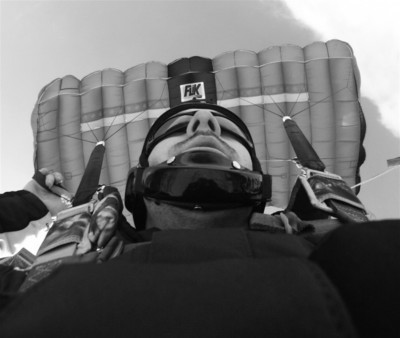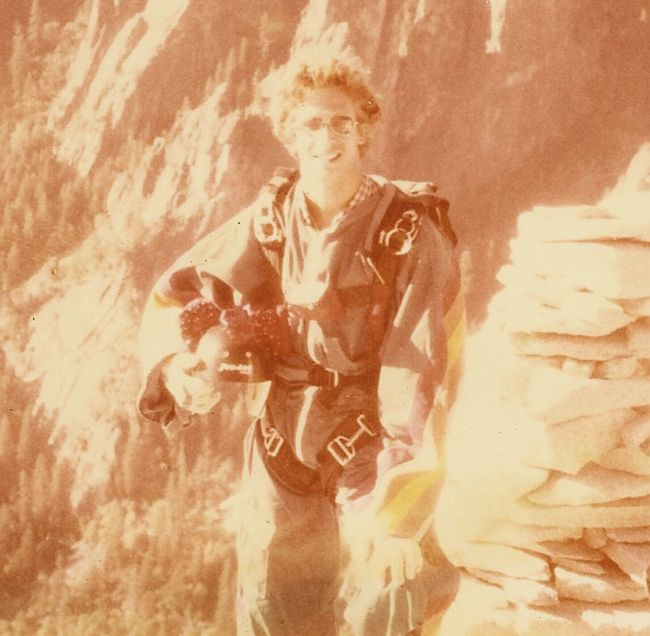Recommended Posts
tbrown 26
QuoteLike Stratostar said though, how can they do an efficient gear check when some dont even know how the 3 rings work?
Well, that's the price for our having become an affluent "pay a packer" sport. I do my own packing, but I'm not a rigger and I don't really want to devote the time or energy to becoming one. Nor should I have to. But I do keep up with things like checking my slider grommets, container flap grommets, replacing closing loops, checking my soft links and working any twists out of my brakelines on my last packjob of the day.
Parachutist has run a number of good articles about the things jumpers should be self inspecting their rigs for. It would make good sense to include a gear inspection requirement for a license, perhaps even for the A license, as part of the packing course. And it should definitely include assembling a 3 Ring and a RSL. For that matter, have the jumper assemble and line check a completely detached canopy to their system and then pack and jump it.
Being a rigger requires a lot more knowledge and training, but being basically gear competent is realistic, doable, and necessary.
Your humble servant.....Professor Gravity !
tombuch 0
QuoteIt would make good sense to include a gear inspection requirement for a license, perhaps even for the A license, as part of the packing course. And it should definitely include assembling a 3 Ring and a RSL.
That's all part of the USPA "A" license exam process, and is included on both the two and four page yellow cards. If you have a SIM, check the grid at the beginning of Section 4, roughly page 18. Three ring assembly and inspection, and closing loop replacement are in category "H" with additional rigging coverage in the earlier categories. Sadly, many instructors don't bother teaching this stuff, or just teach it to the level of checking the box.
If folks have any issues with student training, it would be a good idea to review the grid and the categories under the ISP...USPA has done a good job of building a comprehensive program, but too often our instructors fail to teach the material, and as well, the students fail to learn. The idea behind putting the entire ISP in the Skydivers Information Manual was to give students access to the TLO's so they could pressure lazy or overworked instructors into covering all the required material. I guess that doesn't always happen.
Tom Buchanan
Instructor Emeritus
Comm Pilot MSEL,G
Author: JUMP! Skydiving Made Fun and Easy
Instructor Emeritus
Comm Pilot MSEL,G
Author: JUMP! Skydiving Made Fun and Easy
Akey 0
how can they do an efficient gear check when some dont even know how the 3 rings work
Just a point on knowing about something and recognising a fault. I think it comes down to seeing money. Everyone knows what a 50p coin looks like (if your english, i guess 50c if your american etc.) but i doubt you will know the number of edges, perhaps the writing on it, or its exact layout, person on it etc. I think it is the same with a rig. You know what it is supposed to look like, so if it isn't you are able to say so.
Just throwing out ideas.
Just a point on knowing about something and recognising a fault. I think it comes down to seeing money. Everyone knows what a 50p coin looks like (if your english, i guess 50c if your american etc.) but i doubt you will know the number of edges, perhaps the writing on it, or its exact layout, person on it etc. I think it is the same with a rig. You know what it is supposed to look like, so if it isn't you are able to say so.
Just throwing out ideas.
DougH 270
A coin analogy???  If you mix up coins you may loose a full cents, if you mix things up with your rig you may loose your life!!!
If you mix up coins you may loose a full cents, if you mix things up with your rig you may loose your life!!!
Sky diving equipment isn't very complicated, but there are still a lot of important details you need to focus on. Right and wrong can look rather similar so it really helps to know how to assemble things like three rings!!!
Sky diving equipment isn't very complicated, but there are still a lot of important details you need to focus on. Right and wrong can look rather similar so it really helps to know how to assemble things like three rings!!!
"The restraining order says you're only allowed to touch me in freefall"
=P
=P
As a rigger who's seen people do all sorts of weird shit to their gear that is potentially dangerous... no, it shouldn't. it would only encourage the lazy and stupid to not really learn, but assume they can do things because others can.
I agree with you that people should learn their gear, but it is unfortunately a truth that many don't want to. I'd rather those people at least left the work to someone who knows what they're doing.
I agree with you that people should learn their gear, but it is unfortunately a truth that many don't want to. I'd rather those people at least left the work to someone who knows what they're doing.
"Some people follow their dreams, others hunt them down and beat them mercilessly into submission."
Most skydivers' seeming indifference to and lack of knowledge of their gear baffles me. I want to know everything about how that thing that saves my life works. I think that a working knowledge of all parts of a rig would be a good requirement for a B or C license, and a rigger level understanding of a rig would be a good requirement for a D license. I base my opinion on years of observing pilots in the general aviation business and how the outcome of emergencies was positive or negative based on whether the pilot was a licensed mechanic or not. Not a scientific test or anything, just watching for 40 years and noticing that the mechanic pilots bust their asses alot less when things go badly. Understanding of equipment provides options when said equipment ( that is sustaining your life) malfunctions...
Just burning a hole in the sky.....
Just burning a hole in the sky.....
QuoteYou know what it is supposed to look like, so if it isn't you are able to say so.
Yea right, if you only knew how many EXP. jumpers get tripped up during a ratings course on the friken gear check when all kinds of easy stuff is messed up and it should be found by them, and they don't find it.
you can't pay for kids schoolin' with love of skydiving! ~ Airtwardo
I've never even pulled my cut away handle. Someone showed me how to service the 3 ring release system tho' (requirement for A), so I reckon I could put it back together again after cutting away (on the ground).
I think it would be good to require students to learn all the parts of the rig and what they do, as well as parts which have options to them, as well as the pros and cons of those options, such as the links.
I think it would be good to require students to learn all the parts of the rig and what they do, as well as parts which have options to them, as well as the pros and cons of those options, such as the links.
Blue skies & happy jitters ~Mockingbird
"Why is there something rather than nothing?"
"Why is there something rather than nothing?"
pincheck 0
Not a rigging requirement but a understanding of your gear and being able to do maintenance on it yes.
Billy-Sonic Haggis Flickr-Fun
Billy-Sonic Haggis Flickr-Fun
tombuch 0
QuoteI've never even pulled my cut away handle. Someone showed me how to service the 3 ring release system tho' (requirement for A), so I reckon I could put it back together again after cutting away (on the ground).
Here's a fun rainy day project....
Most suspended harnesses will allow you to hook up your own container and then cut it away. If the one at your DZ isn't configured for this, your local riggers can probably set something up. Try it. Then, with the oversight of your rigger or instructor, put the three rings back together. While you are at it, have them show you how the system actually works, and how it can be mis-configured. Gather a small group on a windy or rainy day and learn this stuff together.
If nothing else, when you take your rig to be repacked, actually pull both handles while standing with your rigger. It doesn't take any special tools or set-up, just a plastic bag to store your opened rig in.
Too often we look to testing and license standards as the motivater to learn, but in this sport (umm, actually in life itself) we can and should keep learning because we want to, not because we have to. If you have a question or see a hole in your knowledge, seek assistance, answer the question, or fill the hole.
Tom Buchanan
Instructor Emeritus
Comm Pilot MSEL,G
Author: JUMP! Skydiving Made Fun and Easy
Instructor Emeritus
Comm Pilot MSEL,G
Author: JUMP! Skydiving Made Fun and Easy
If you've never pulled your cutaway on the ground, how will you know how it feels to do so when you really need it? When I do a reserve repack, I make the rig owner simulate a malfunction... throw, chop, reserve (with RSL disconnected). It's astounding how many people have never pulled their own handles.
There's nothing magical about how a cutaway system works. Next time the weather sucks, spend some time with your friendly rigger. Most love to teach things like this.
Do or do not, there is no try -Yoda
There's nothing magical about how a cutaway system works. Next time the weather sucks, spend some time with your friendly rigger. Most love to teach things like this.
Do or do not, there is no try -Yoda
I will DEFINITELY do those things ASAP-- thanks for this suggestion!
Blue skies & happy jitters ~Mockingbird
"Why is there something rather than nothing?"
"Why is there something rather than nothing?"



.thumb.jpg.4bb795e2eaf21b8b300039a5e1ec7f92.jpg)




>far brighter than 99% of skydivers and 80% of licensed riggers.
Side note - that's one reason I like the sort of non-cascaded line systems canopies like the Nitro have. No sewing, no guessing.
Share this post
Link to post
Share on other sites